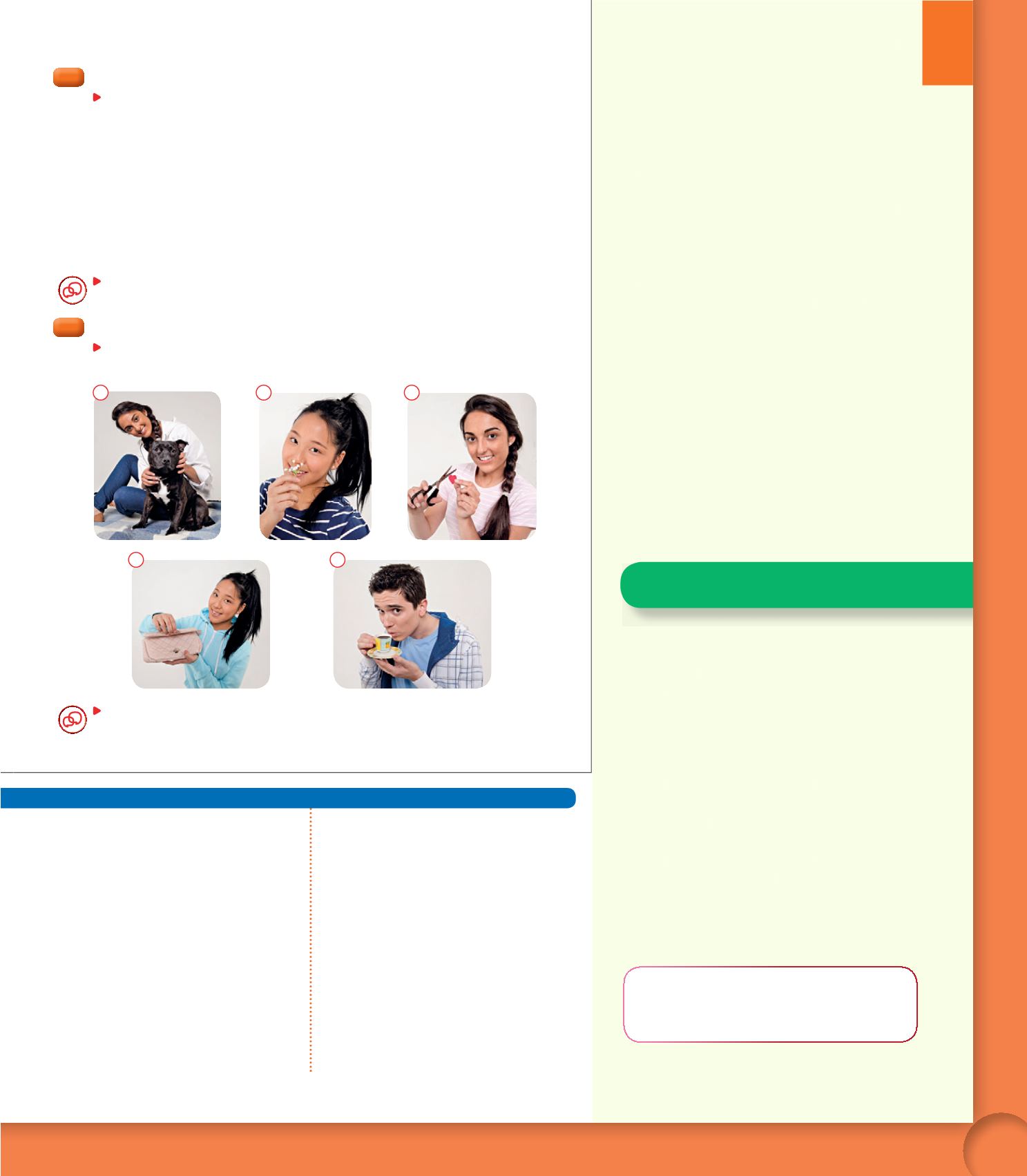

101
DESAFÍO 3
Unit
6
Activities
63.
After finishing this activity, ask students to write
five new words and their diminutive forms in
their notebooks. You may want to check their
work for accuracy. Then have student pairs
test each other using the words they listed in
their notebooks.
64.
Clarify that a diminutive can express several
things. For instance, the word
cuentito
in #4
could express both small size and affection. To
expand this activity, have student pairs choose
one of the sentences to create a conversation.
Challenge students to keep the conversation
going for as long as they can. Emphasize that
they should not use English at any point.
For example:
A.
Vamos a hacer un viajecito de tres días
por la costa
.
B.
¡Qué bien! ¿Y qué van a ver?
A.
Pues tenemos pensado ir a unos pueblitos
de pescadores muy pintorescos
.
Answer Key
62.
Se usan adjetivos como
little, tiny, small
.
También hay algunos nombres en diminutivo
(e.g.,
auntie, kitty, doggy, dearie, blanky,
birdie
) y algunos apodos (e.g., Johnny,
Susie, Jimmy).
63.
1. librito
5. trenecito
2. amiguito
6. banquito
3. novelita
7. calorcito
4. naricita
8. grandecito
64.
1. duración
5. tamaño
2. ironía
6. afecto
3. tamaño
7. afecto
4. tamaño/afecto
8. afecto
▶
Answers will vary.
65.
Answers will vary
▶
Answers will vary
HERITAGE LANGUAGE LEARNERS
r
Explain that the suffixes
–ón, –azo, –ote,
and
–udo
indicate large size or excess, but can
also add a pejorative tone. For example:
cuchara
→
cucharón
,
soltero
→
solterón,
bueno
→
buenazo, coche
→
cochazo
,
libro
→
librote
,
palabra
→
palabrota
,
barba
→
barbudo
,
nariz
→
narigudo
. Ask students
to come up with a list of ten words with
these suffixes. Then have them explain
whether the suffix indicates just large size or
adds a pejorative tone. Next, have students
write a sentence with each of their words.
Finally, invite students to share some of their
sentences with the class.
MULTIPLE INTELLIGENCES:
Verbal-Linguistic Intelligence
r
Explain that the diminutive suffix
-ete/-eta
is
often used to denote affection and add
humor. For example:
amigo
→
amiguete,
gordo
→
regordete
. This suffix can also add
a new meaning to a word. For example:
avión
→
avioneta, camión
→
camioneta
,
historia
→
historieta, camisa
→
camiseta, libro
→
libreta
. Ask students to work with a partner
and find more examples of words with this
suffix. Then have them write a sentence with
each word they find. See how many
sentences student pairs can write correctly.
Gramática – Los diminutivos
6
4
¿Qué expresan?
Decide.
¿Qué matices añaden los sufijos diminutivos en estas oraciones?
¿Se refieren al tamaño o la duración de algo, o aportan algún otro valor?
Justifica tus respuestas.
1.
Vamos a hacer un viajecito de tres días por la costa.
2.
Tengo que leerme esta novelita de 500 páginas. ¡No terminaré nunca!
3.
La profesora nos ha pedido que escribamos un poemita de ocho versos.
4.
Mercedes, ¿quieres que te lea un cuentito antes de irte a dormir?
5.
Me encanta el cochecito de Marga. Es perfecto para circular por la ciudad.
6.
Me he comprado un vestidito precioso para la fiesta.
7.
Mónica debería perder peso, está un poco gordita.
8.
Dale un besito a papá.
Escribe
tres ejemplos más usando diminutivos. Léeselos a tu compañero(a)
para que decida qué matices aportan en cada oración.
6
5
Con detalle
Escribe
un pie de foto para cada imagen usando diminutivos.
Modelo
1.
A Asha le encanta salir a pasear con su perrito.
Habla
con tu compañero(a). Comparen lo que han escrito y decidan si los diminutivos
que han elegido describen bien las imágenes.
4
5
3
2
1
Additional Resources
Fans Online activities
Practice Workbook
333
Book 4 Unit 6


















